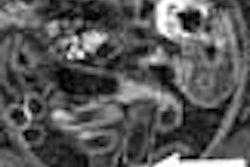Good old axial slices do the best overall job of imaging the larynx and hypopharynx, though other planes and techniques have their own strengths, say researchers from the University of Erlangen-Nuremberg in Germany. The group reported on the results of multidetector-row CT in 40 patients, using multiple exam and reconstruction techniques.
The limitations of laryngoscopy in cancer assessment are well-known, while the evaluation of edema, fibrosis, and inflammation are difficult to assess both directly and radiologically, Dr. Michael Lell and colleagues wrote in European Radiology (October 8, 2004, online edition).
Both CT and MRI are used to assess the infiltration depth and to detect submucosal spread of cancer, while pretreatment CT imaging has been shown to enable stratification of patients with the most common cancer type, laryngeal squamous cell carcinoma, they wrote.
"While inspiration, phonation, and the Valsalva maneuvers are well-established in barium swallow studies, there are few reports on the value of these functional studies performed with CT," they stated. "Functional studies have been shown to be valuable in follow-up examinations.... The aim of this study was to investigate whether the image modality has any impact on the quality and diagnostic value of the images, separately for each region of interest, and to identify the image type offering the highest diagnostic power."
The researchers prospectively examined 40 consecutive patients (nine women, 31 men, median age 58) with a high clinical suspicion or established diagnosis of laryngeal tumor (n = 24) or hypopharyngeal tumor (n = 16). Four patients had previously undergone radiotherapy of the neck.
After intravenous administration of 120 mL of contrast material (Ultravist 300, Schering, Berlin) with a power injector (2.5 mL/sec), MDCT images were acquired on a Somatom Volume Zoom scanner (Siemens Medical Solutions, Erlangen, Germany) using 4 x 1-mm collimation, 165 mAs, 120 kVp, pitch 1.5, and 0.05-sec rotation time. Images were acquired from the skull base to the aortic arch with quiet breathing, followed by scans of the larynx during E-phonation and a modified Valsalva maneuver.
Images were reconstructed at 1.25 mm (1-mm interval) using a standard kernel and a small (70-mm) field-of-view for the region of the larynx and hypopharynx for three techniques: quiet breathing, E-phonation, and the Valsalva maneuver. Two interpreting radiologists, blinded to all clinical results, read the images interactively in the axial, coronal, and sagittal planes resulting in nine image types (three maneuvers times three planes). The radiologists subjectively rated image quality for each type.
According to the results, tumors were located in the larynx in 23 patients (n = 7 T1, n = 6 T2, n = 3 T3, n = 1 T4), and staging was based on CT and clinical findings, including biopsy.
"Histopathologic and CT staging differed in two patients with hypopharyngeal and one patient with laryngeal cancer, in whom CT was suspicious for cartilage involvement, which could not be confirmed," the authors wrote. On the other hand, "four patients with suspected tumor were correctly shown to be free of tumor on CT," they wrote following panendoscopy with multiple deep biopsies and clinical follow-up averaging 17 months.
Quiet breathing did not significantly degrade image quality overall. Motion artifacts did reduce the diagnostic value of the exams in two E-phonation scans, and in seven cases diagnostic value of CT images was reduced in images of the Valsalva maneuver. Suboptimal scans were not repeated, even when the maneuver was performed incorrectly, in an effort to limit radiation exposure.
"Differences between image types were statistically significant," the authors wrote. "The axial plane was superior in overall image quality, and the delineation of tumor, pyriform sinus, vocal cords, and fat within the parapharyngeal/visceral space. The coronal plane was best for delineating the ventricle and the paraglottic space, the sagittal plane for the retropharyngeal and preepiglottic space."
Sensitivity for tumor detection, specificity, and accuracy were 0.92, 1.0, and 0.93, respectively, for quiet breathing with axial slices; 0.94, 0.8, and 0.92 for E-phonation with axial slices; and 0.85, 1.0, and 0.87 for the Valsalva maneuver with axial slices.
The entire neck must be imaged in order to display the tumor and lymph node metastases accurately, the authors wrote, noting that the MDCT protocol in the study offered high spatial resolution within a reasonable scan time.
"We chose 1.25-mm slice thicknesses in all orientations to minimize partial-volume artifacts, despite the reduced contrast-to-noise ratio compared with 3-mm-thick MPR images," they explained. "Image quality was ranked best for (quiet breathing), followed by (E-phonation) and (Valsalva maneuver), but in each group the image quality was comparable for axial, coronal, and sagittal views."
Reformatting offered little additional information in advanced tumors, but did allow the craniocaudal extension to be assessed more precisely. Along with quiet breathing, E-phonation was seen as helpful in assessing the larynx. The Valsalva maneuver was able to demonstrate vocal cord mobility in patients who could not phonate constantly for eight to 10 seconds, but the maneuver expanded the ventricle in only a minority of cases, did not enable the medial edge of the cords to be separated completely, and was therefore seen as less useful in laryngeal cancer assessment.
Tumor margins were well-delineated in both E-phonation and Valsalva-maneuver imaging "because distension of the normal pyriform sinus caused mucus retention to disappear," the authors wrote.
"Examination of the neck during (quiet breathing) should be the standard modality, but (E-phonation) can improve diagnostic accuracy in patients with small laryngeal and hypopharyngeal tumors, and provide information concerning vocal cord mobility," the group concluded. "The transverse image plane is still the basis for the tumor assessment, and coronal reformations were found to be the most valuable supplementary image plane."
By Eric Barnes
AuntMinnie.com staff writer
November 3, 2004
Related Reading
MDCT drives important changes in U.K. healthcare, August 10, 2004
Accelerated radiotherapy improves head and neck cancer outcomes, September 19, 2003
Chemoradiation study aims for 80% survival in laryngeal cancer, February 17, 2003
Copyright © 2004 AuntMinnie.com



















